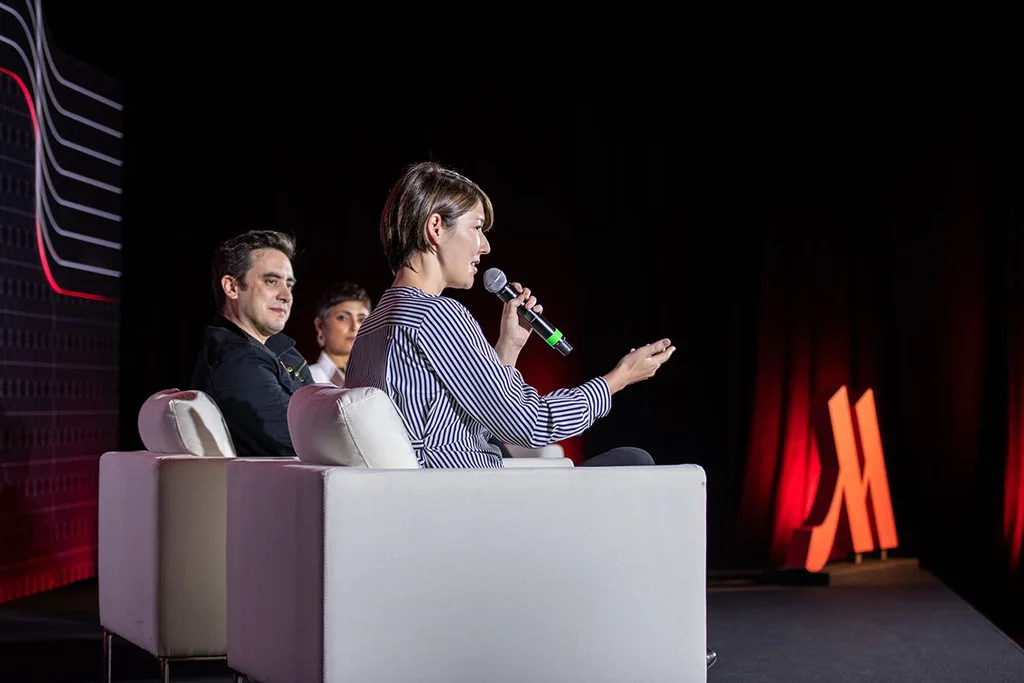Today, inspiring a new perspective is not an easy feat. With social media at a fever pitch and the world in an (arguably) tumultuous time, finding creativity to inspire and incite change takes courage, determination and of course, persistence. Hiromi Ozaki, better known as the artist Sputniko!, is doing just that. The British-Japanese artist is known for her film and multi-media installation works inspired by how technology impacts society and people’s values – in particular focusing on gender issues.
Sputniko! was chosen by TED as one of the twenty young researchers, activists, artists, and designers to become a TED Fellow. Having studied mathematics and computer science as an undergraduate and design, Ozaki has since merged her passions, creating film, song and multimedia pieces that reflect on the ways in which technology is altering the values of society. Her 2010 work, titled Menstruation Machine-Takashi’s Take, was a device that mimics the bleeding and discomfort caused by the female menstrual cycle. Its goal was to allow men to experience first hand the feeling of menstruation, and the instalment sent waves through the world of contemporary art – not to mention, led Ozaki to be announced as Vogue Japan’s Woman Of The Year. Since then, she has continued to create unique and innovative projects that incite conversation about the social, ethical, and cultural consequences of emerging technologies.
Her most recent being that of an imaginary academy, the titular Tokyo Medical University for Rejected Women. The work responds to a scandal that broke out at Toyko Medical University in August 2018, when it was exposed that the university had been deliberately lowering the entrance exam scores of female applicants for years. Critiquing the cultural gender biases of Japan, specifically the institutional sexism of the Japanese medical industry, Ozaki and fellow artist Tomomi Nishizawa created a fictional university for all of the rejected female applicants to Tokyo Medical University. Their three large scale digital photographs take the viewer on a tour of the great achievement of Tokyo Medical University for Rejected Women: turning men into robot-doctors for hospitals across Japan.

On top of her incredible artworks, Hiromi is a TED Fellow that speaks across the world inspiring others in the creative fields. Marriott Hotels global partnership with TED continued for its third year with its Asia Pacific edition of the Marriott TED Fellows Salon which took place at Singapore Marriott Tang Plaza Hotel. The Singapore event saw Ozaki, alongside scientist Andrew Pelling, share their stories on the topic of ‘Creativity and Thinking Outside The Box’ – something both TED Fellows have proved to do in their work time and time again.
This event was part of a global tour of Marriot TED Fellows Salons in 2019 with highlight events in Cape Town, Costa Rica, Rotterdam and San Francisco. On top of an engaging and thought-provoking talk, marie claire sat down with Ozaki to discuss everything from how important it is for women to think outside the box to how she herself has thought differently.
On Women Thinking Outside The Box: Where I grew up, in Japan especially, there are many rules on social manners that are expected from women, the way they talk or the way they act or how they should be in a family. And I think it’s not just Japan, it happens everywhere in the world. And it’s so important for women to question these manners and rules that are almost silently pressured since they are very young. I think it just happens from the media or their parents or their classmates and it’s really tragic for me. So it’s especially important for women to realise that there is this box and that needs to be questioned and that you just need to move out if you want to live your own life fully. Because I’m just against the boxes, especially in Asia.
On The Tokyo Medical University For Rejected Women: A year or so ago there was this big scandal in Japan that found that prestigious medical schools across the country were deducting points of female applicants deliberately so that women didn’t enter the schools to become doctors. In 2018, they found that universities were doing this in Japan, so these schools apologised and said they’d never do it again. But women were furious that they had been doing this for years and years. And their excuse was that ‘Well, women, even if they become doctors, when they get married and have children, they will quit. So no point in educating women to become doctors.’ It’s crazy! And that’s the excuse that they gave. That just illustrates the extent of discrimination against women in Japan and in society. It’s not just business, academia did it too. So my project is called Tokyo Medical University for Rejected Women. It’s a fictional school that we created, founded by these women rejected from these medical schools in Japan. And it’s a very, very cynical take on the whole thing, a black humour approach. So we are saying that Japan just loves elite male doctors so much, they love men and they don’t want us anywhere in the medical industry. Well because we’re talented, we want to contribute to the industry. We’re going to build the best elite male doctors ever that might even replace the real. So we’re going to build them and put them in boxes and put them on drones and deliver them throughout Japan as well.

On What Role Technology Plays In Our Creativity: I think technology is currently a driving force in how we shape society and also how we shape values or lifestyle or how we communicate with each other. So because it’s a force of change, I think that’s when a lot of creativity is needed or is used. I think it provides a lot of room for creativity. But then also, it’s important to also be creative in imagining different futures that we could be heading towards, so that we could talk about it and we could also be aware, where we could be moving towards. Also, I use creativity to discuss issues like gender discrimination in Japan. Also, technology is still such a very male-dominated world and especially in the US and Europe, it’s very white male-dominated. Japan is Japanese, Chinese male dominant. So it’s a risk that these people are shaping so much of the world and with such little insight or input, diverse insight. So that’s another thing that I feel is a big risk and I want to make people aware, bring more people into the discussion.
On Creativity Limiting Our Creativity: Sometimes it limits A, but then it opens up another C. And I think it’s always been doing that to us, since thousands of years ago. Like printing or photography maybe. It’s hard to say. I almost treat technology as almost part of nature to me. So it’s hard for me to say it limits it. I think we evolve together.
How Would You Encourage Other Women To Get Creative In Their Roles: I always tell the female students to be very confident in their ideas or what they’re doing because I find that women tend to be more insecure about their ideas. Women, they’re doing amazing things, but they’re kind of modest, so I say be confident, believe in your ideas. If you sometimes feel like you’re not capable of doing the idea, remind yourself that maybe that’s the girl, the female. I do say that word, there’s a word in Japanese, and it means “like a spell”. Maybe that’s a spell put on you from a society that you can’t, so you try to go over it and keep on being confident. Because I do that myself. When I feel insecure about something I go, wait, maybe this is a spell from society. Go away. I can do this. I keep telling myself that. And then if you’re confident I think people become confident in you.










